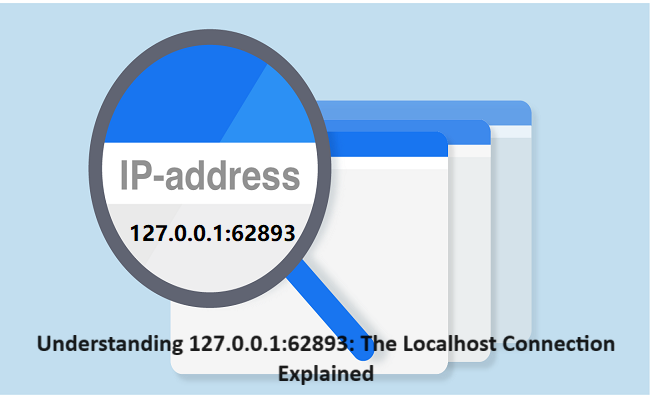In networking and software program improvement, IP addresses and port numbers are important in how our computer systems communicate internally and with other devices. One such mixture that often seems, mainly for the duration of development and troubleshooting, is 127.0.0.1:62893. This article will delve deep into this deal with way, its importance, and how to troubleshoot commonplace issues related to it.
What is 127.0.0.1:62893?
To recognize 127.0.0.1:62893, we want to break it down into components:
- 127.Zero.0.1: This is called the “localhost” or loopback address. It’s a unique IP address that constantly refers back to the contemporary tool you use.
- 62893: This is a port-wide variety. Ports are channels or doors via which data can be despatched or acquired.
When mixed, 127.Zero.0.1:62893 represents a selected connection for your neighbourhood device, using port 62893.
The Significance of Localhost (127. Zero.0.1)
Localhost (127.0.0.1) serves several essential purposes:
- Testing and Development: Developers use localhost to test applications while not having a web connection.
- Security: It provides a secure way to run offerings that should not be accessible from external networks.
- Network Diagnostics: It’s beneficial for troubleshooting network problems on a neighbourhood device.
Understanding Port 62893
While 62893 is not a standard port quantity assigned to precise services, it is frequently used dynamically via diverse programs, in particular for the duration of development and trying out levels. Some not unusual makes use of include:
- Debugging Tools: IDEs and debugging software programs might use this port for conversation.
- Caching Systems: Services like Memcached occasionally make use of this port.
- Custom Applications: Developers may also assign this port to their applications through testing.
Benefits of Using 127.Zero.0.1:62893
- Isolated Testing Environment: Provides a secure area for checking out without affecting outside systems.
- Improved Security: Limits the right of entry to nearby offerings, lowering capability attack surfaces.
- Network Concept Learning: Helps in the knowledge of essential networking standards.
- Efficient Troubleshooting: Makes it less complicated to pinpoint and remedy network-associated troubles.
- Resource Conservation: Reduces the want for external network sources throughout improvement.
Common Issues and Troubleshooting
When working with 127.0.0.1:62893, you might come across some troubles. Here are common troubles and their answers:
1. Connection Refused Error
Symptom: You receive a “Connection Refused” error while trying to connect with 127.0.0.1:62893.
Solution:
- Ensure the service you are trying to reach is honestly jogging on port 62893.
- Check if any firewall settings are blockading the connection.
- Verify that no different utility is the use of the identical port.
2. Address Already in Use Error
Symptom: When beginning a provider, you get an “Address Already in Use” mistake.
Solution:
- Use network diagnostic tools like netstat (Windows) or lsof (Unix/Linux) to perceive which process is used for the port.
- Stop the conflicting procedure or pick out an exceptional port on your application.
3. Slow Connection
Symptom: Connections to 127.0.0.1:62893 are strangely gradual.
Solution:
- Check system assets to ensure your pc is manageable.
- Verify that your local host access in the host record is efficaciously configured.
Best Practices for Using 127.0.0.1:62893
- Security First: Only expose offerings strolling on localhost to the public internet with the right safety features.
- Port Management: Keep a list of packages that use precise ports to avoid conflicts.
- Regular Testing: Periodically check localhost connections to ensure they are functioning efficaciously.
- Documentation: Maintain clean documentation of your local host services and their port assignments.
Future Trends and Considerations
As technology evolves, using local hosts and particular ports like 62893 remains vital in improvement and networking. Some emerging traits consist of the following:
- Containerization: Technologies like Docker are changing how builders use localhost for testing and deployment.
- IPv6 Adoption: The growing use of IPv6 might also affect how localhost is used and configured.
- Security Enhancements: Growing cybersecurity concerns can also cause extra sophisticated local-host security practices.
Conclusion
They are understanding 127.0.0.1:62893 is vital for developers, community directors, and everyone involved in software checking out or troubleshooting. This local deals with, and port aggregate plays a vital role in creating steady, remoted environments for development and trying out. By mastering the principles behind localhost and port usage, you could improve your improvement approaches, enhance protection, and troubleshoot network problems more correctly.
Remember, at the same time as 127.Zero.0.1:62893 may look like a small detail in the enormous global network. Still, its proper use and know-how can substantially impact the performance and security of your improvement environment.
FAQs
What is 127.0.0.1:62893?
A local connection the use of IP cope with 127.0.0.1:62893 and port 62893 for trying out and development.
What does 127.0.0.1:62893?
The “localhost” deals with, referring to, the local gadget itself.
Why use port 62893?
A dynamic port is used for debugging and trying out software programs regionally.
Benefits of the use of 127.0.0.1:62893?
- Secure Testing: Isolated from outside networks.
· Efficient Troubleshooting: Local difficulty diagnosis.


